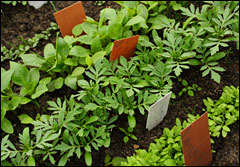“A natural diet lies right at one’s feet.” — Masanobu Fukuoka, The One-Straw Revolution
It’s springtime here on my mountain farm, and that means an explosion of activity. We’re starting seeds in one greenhouse, and finishing construction on another. Fields are being tilled, and we’re putting in the very first sugar-snap peas and spring onions. We’re depleting a pile of composted manure bucket-load by bucket-load, building up raised beds for a season of salad-greens production.

All this can be yours.
Photo: iStockphoto
But the activity that really inspires me is taking place underfoot, in the soil itself — the billions of microorganisms rousing themselves from winter dormancy, converting dead plant matter into humus, and making the soil’s vast array of micronutrients available to the cultivated plants that will soon live there. With major assistance from the sun, the plants will soon deliver those nutrients to us, along with vibrant flavors. I can’t wait for the sweet burst of the first sun-warmed pea pod I pull from the vine.
As I direct the unruly orchestra of activity required to launch the growing season on this 2.5-acre farm, which supplies 25 CSA members, several chefs, a farmers’ market stand, and a household, I sometimes catch myself waxing nostalgic for springtimes past, before I turned pro — when I helped tend a little community-garden plot in Brooklyn, and before that, a front-yard patch in Austin, Texas. Then, I was just growing food for myself and my friends, and phrases like “crop failure” and “harvest schedule” didn’t haunt my nights.
As I learned back then, there’s no need to leave food production completely to the pros. You — one of the 99 out of every hundred people who, the USDA tells us, don’t live on a farm — can experience the considerable pleasures of growing food, without the accompanying headaches of market farming.
Don’t Just Consume — Produce!
In his seminal 1977 polemic The Unsettling of America: Culture & Agriculture, Wendell Berry delivered a pretty devastating critique of the modern household. Historically, most households were sites of a rich and varied set of activities. People actively turned plants and animals growing nearby into food and clothes, and trees and river rocks were converted into shelter. Households represented the balance of ongoing production and consumption cycles, and waste as such didn’t exist. What couldn’t be reused or composted got burned for heat — and its ashes spread in the field.
Berry can be criticized for imbuing such hardscrabble existences with a bit too much idyll, but his characterization seems accurate enough.
By contrast, in the modern household, consumption has triumphed over production, which takes place not in the kitchen, garden, or woodlot, but rather in some distant factory. Products flow into the house, often from great distances, and eventually leave as waste, creating the need for vast landfills and wastewater-treatment plants. “The modern home,” writes Berry, “has institutionalized the divisions and fragmentations of modern life.” By fetishizing consumption, we’ve created the world’s most energy-intensive society by a wide margin — the U.S. burns through 25 percent of world oil production every year, even though we represent just 5 percent of world population.
Home and neighborhood gardening is a fast, (literally) dirty, and fun way to subvert the triumph of unmitigated consumption. There’s no need to revert to an austere homesteading existence; simply identify a sunny spot in your yard, and prepare to get your hands dirty.
There’s all manner of information out there for anyone interested in home vegetable gardening. The best recent source I know is Food Not Lawns: How to Turn Your Yard Into a Garden and Your Neighborhood Into a Community, by H.C. Flores. This excellent book contains information on everything from composting to seed saving.
If you really want to juice up your home gardening efforts, consider getting a few backyard laying hens. Not only is this manner of bird-keeping extraordinarily fun — yes, the hens do exhibit strong individual chicken-alities (if you’ll pardon the neologism) — but it’s also extremely productive. With chickens, you can turn table scraps and garden waste (plus a little grain) into delicious eggs and rich fertilizer. A little straw used as bedding eliminates all bad smells.
If this idea strikes your fancy, first check local codes, and then find a copy of Barnyard in Your Backyard, edited by Gail Damerow, the bible of micro-scale husbandry.
If you don’t have access to a yard, don’t fret. All over the country, urban vegetable gardening is booming. The American Community Gardening Association can help you locate any growing opportunities near you. Some of my fondest memories of living in New York City come from my time at Hollenbeck Garden in Clinton Hill, Brooklyn — a rich polyculture of economic statuses, ethnic backgrounds, ages, and gardening styles that produced great food and even better parties.
And if you can’t find a garden plot, there are always windowsill pots, which can produce more delicious food than you might think.
Spring is here. You don’t have to be a farmer to get your hands in the dirt. The sensual pleasures of food don’t start at the table, but rather in the field. Get out there.

